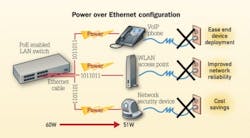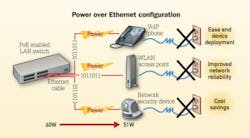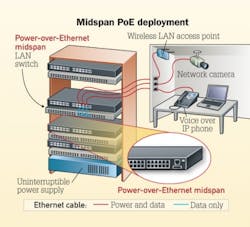Use PoE to reduce energy consumption
Midspan Power over Ethernet devices have capabilities that can translate to bottom-line dollars saved when used wisely.
By Daniel Feldman, Microsemi Corp.
Power over Ethernet (PoE) technology has become an increasingly important tool for simplifying network deployment while improving remote-management capabilities and overall energy efficiency. The latest advances have presented new opportunities to further reduce power consumption and associated energy costs.
PoE enables data and power to be carried over a single Ethernet cable. The technology delivers up to 60 watts (W) of safe, uninterrupted power at voltages from 50 to 57 volt (V) levels over the existing local area network (LAN) infrastructure, in support of the IEEE 802.3at-2009 standard. IEEE 802.3at-2009 is backward-compatible with and supersedes IEEE 802.3af-2003. PoE enables network administrators to deploy Voice over Internet Protocol (VoIP) phones, wireless LAN access points, IP security cameras, access-control systems and other powered devices (PDs) anywhere throughout the facility without having to install alternating-current (AC) outlets or send electricians to pull cables, modify building plans or get safety approvals. By eliminating the need for separate electrical wiring and power outlets, PoE can deliver savings of up to 50 percent compared to traditional network powering infrastructures.
In addition to simplifying and cutting the costs of network deployment, PoE technology offers advanced management capabilities that enable network administrators to significantly improve ongoing infrastructure reliability while cutting operational expenses.
The midspan advantage
PoE can be implemented either as part of a PoE-enabled switch, or by installing PoE midspans between an existing switch and the network PDs. Midspans offer the easiest approach for quickly deploying high-power PoE, by simply inserting them between an existing switch and PDs.
Unlike PoE-enabled switches, midspans enable PoE ports to be added incrementally over time rather than all at once during initial installation. They also typically improve mean time between failure (MTBF) rates compared to PoE-enabled switches, which concentrate high-power dissipation from the PoE section and the highly sensitive data section into a single box. Finally, midspans are a more cost-effective and scalable solution than PoE-enabled switches, and make it easier for network administrators to upgrade their power infrastructure independent of their data infrastructure. Often, campus administrators cannot justify the expense of upgrading to a new PoE-enabled switch when their existing switch might be only a few years old, and when they may only need a few ports with PoE capability.
Power management and cost savings
It is midspans’ ability to monitor, reduce and manage power usage that offers network administrators the biggest opportunity to significantly reduce energy consumption and associated costs.
Midspans can be used in three key ways to squeeze the most power efficiency possible out of the network. The first is to leverage midspans’ ability to deliver power over all four pairs of structured cable wires. Today’s midspans feature two interfaces, each of which takes 25.5 W into the same box (one over the two pairs using lines 1, 2, 3 and 6 and the other over the two pairs using lines 4, 5, 7 and 8). Connecting the two doubles the standard power delivery to 51 W while still fully complying with the 802.3at-2009 standard. Alternatively, four-pair powering can be used to cut power dissipation. Specifically, instead of delivering 51 W over Category 5 cable, this same four-pair configuration can be used to power two-pair devices with 30 W of power, which dissipates up to half the power while consuming almost 15 percent less energy compared to conventional two-pair solutions—a savings of more than 2.5 W per port.
Using this approach with a 12-port midspan, power dissipation is reduced by approximately 30 W, which yields an annual savings of 263 kWh (30 W x 24 hours x 365 days). At $0.10/kWh, this is $26 in annual savings per 12 wireless LAN access points.
The next tactic for improving power efficiency is to use midspans’ remote PD monitoring and configuration capabilities. Network administrators can monitor per-port and total power consumption, and configure PDs for instant and scheduled port on/off functions, as well as uninterruptible power supply (UPS) status port on/off functions. An organization with 12 wireless LAN access points could cut its round-the-clock operation down to, say, 10 hours per day (8 a.m. to 6 p.m. Monday through Friday), which would reduce usage from 2,933 kWh (12 APs x 27.9 W x 24 hours x 365) to 837 kWh (12 APs x 27.9 W x 10 hours x 250 days), for a savings of 2,096 kWh per year. At $0.10/kWh, that is a savings of $210 annually.
The third way to improve power efficiency is to minimize the effects of idle power consumption. Many PoE midspans and switches use switching power supplies (SPSs) that are 90 percent efficient at full load, which means as much as 220 W of AC power is consumed for 200 W of PoE power, or up to 440 W for 400 W of PoE power. The problem is that SPS units have high switching power losses when idle—as much as 20 to 40 W with zero W load for 200-W-rated units, and 40 to 80 W with zero W load for 400-W-rated units. The solution is to employ midspans that come with built-in power supplies that are capable of powering real needs, and only upgrade to full power per port in case there are loads requiring that, via an external power supply. With this improved efficiency, it is possible to use a small (450 W) internal power supply to handle all real-time requirements, and then augment it with an external 450 W or 1 kW power supply when needed. This yields annual savings of 394 kWh/year (45 W x 24 hours x 365 days), which at $0.10/kWh equates to $39 annually for every 12 wireless LAN APs.
Calculating the aggregate savings possible, organizations can save up to $485 annually using the latest energy-efficient PoE midspan technology. This includes the following.
Four-pair powering: Saves 2 W per port or $53/year.
Power management: Saves $419/year by enabling ports to be turned off when not needed.
Smaller internal supplies (augmented with external supplies as required): Saves $39/year by reducing idle power consumption.
PoE midspans make it easier to deploy and expand networks, and the latest advances improve operational efficiency. Organizations can improve network availability and energy efficiency while reducing expenditures by choosing the latest high-power PoE midspans, implementing four-pair powering and built-in power management capabilities, while minimizing idle power consumption through smaller internal power supplies.
Daniel Feldman is business unit manager for communications power in the analog mixed signal group of Microsemi Corp. (www.microsemi.com, www.powerdsine.com).


